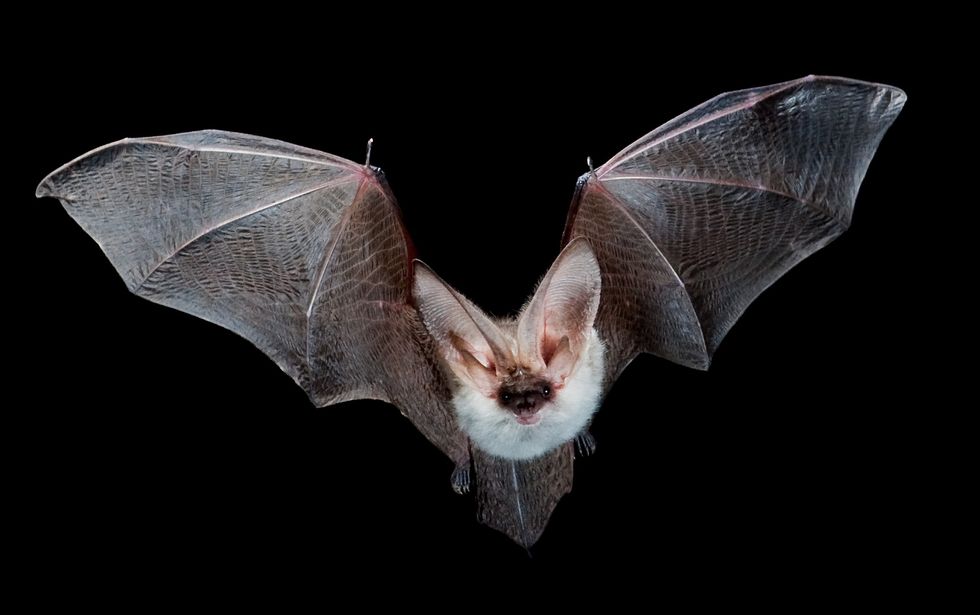The long-eared myotis, Myotis evotis, has long, black ears that when stretched forward can extend about 5 millimeters past the nose, according to Montana Field Guides. The long-eared myotis has the longest ears out of all the myotis species in North America. They weigh from 5-8 grams and their wingspan stretches to 10-12 inches long. Their body has a coloration of light browns and beige with a dark face and dark wings. Their habitat range consists of the northwestern, north central, and eastern United States as well as provinces in Canada stretching from the Atlantic Ocean to Yukon Territory.
Photo (c) Christian Engelstoft
The long-eared myotis spends the winter months hibernating in caves or mines, called hibernacula. They typically choose cracks or crevices within the caves where no air currents rush in. During the warmer months, they will roost outside in cracks or crevices within live or dead trees. According to U.S. Fish & Wildlife Service (USFWS), rarely are these bats found roosting in man-made structures, like barns or sheds.
Similar to most other bat species, the northern long-eared bat will feed at dusk. Their main food source consists of insects such as flies, beetles, moths, leafhoppers, and caddisflies, according to USFWS. Also like other bats, they locate their food using echolocation, which is the use of sound to locate an object in space. The bat will issue out sound waves from the mouth or nose, and if the sound waves hit an object the waves will bounce back to the bat, essentially echoing the waves. This is also how bats travel around their environment.
Diagram of echolocation.
Mating season for the long-eared myotis last from late summer to early fall. After mating, the females will store sperm throughout the winter as they hibernate. Once emerging from their hibernacula, the females will ovulate and fertilize their eggs with the stored sperm. The females will then migrate to a summer roosting spot and give birth. They can only give birth to one pup at a time. According to USFWS, most of the bats residing in a maternity colony will give birth around the same time, which can happen from late May to late July, depending on the location they are roosting in. The offspring can start flying around 18 to 21 days old. The average lifespan of the long-eared myotis about 18.5 years old.
The northern long-eared bat is listed as threatened, according to USFWS. They are not endangered, but they have the capability of becoming endangered in the near future. The main threat that is currently facing them is a disease called white-nose syndrome. White-nose syndrome stems from a fungus that ingests the skin of hibernating bats. It can cause the bat to wake up prematurely from hibernation, which causes the bat to use up its remaining fat reserves. It can also die from its immune system kicking into overdrive to fight the fungus and inevitably the bat’s own body as well. Bats with white-nose syndrome can be seen with a white fuzz around its muzzle, hence the name. The disease has wiped out a large population of bats spanning across the U.S., all the way from the eastern U.S. to parts of north central U.S. The fungus was brought over to North America from Europe. The bats in Europe seem to be adapted to the fungus, however, North American bats are not, and so they are facing great threats from it. For more information about white-nose syndrome and what you can do to help, visit the Center for Biological Diversity’s website. Other sources of mortality include habitat degradation and wind farms.
Image source: scbats.org
Research for white-nose syndrome is underway and there are conservation efforts set to try and reduce or slow the spread of the disease. Having the long-eared bat listed as threatened grants it benefits under the Endangered Species Act, which includes funds, grants, and recovery opportunities, according to USFWS. For more information on how you can help the northern long-eared bat and bats in general, visit U.S. Fish & Wildlife Service’s website. This includes not disturbing their hibernacula and leaving dead or dying trees standing instead of cutting them down. Bats are very important for the environment, and it is crucial that we help preserve them!



















